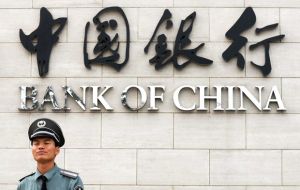MercoPress. South Atlantic News Agency
China eases credit to help boost growth; 7.4% in 2014 was the lowest in 24 years
 In September, China's central bank was reported to have injected 500bn Yuan (80bn dollars) into the five biggest state-owned banks
In September, China's central bank was reported to have injected 500bn Yuan (80bn dollars) into the five biggest state-owned banks China's central bank has cut the level of funds banks must hold in reserve in an effort to boost growth in the world's second-largest economy. The reserve requirement ratio has been cut by 0.5 percentage points to 19.5%.
The central bank said it was trying to increase the banking industry's support for small and rural enterprises, construction of water projects and other activity. Last month, official figures showed China's economy grew by 7.4% in 2014. That was the slowest rate of growth for 24 years.
The rate cut is the first since May 2012, although there have been cuts for select small lenders.
In September, China's central bank was reported to have injected 500bn Yuan (80bn dollars) into the five biggest state-owned banks over concerns about slowing economic growth.
At the time economists said the move could have a similar effect to a cut in the reserve requirement.
Fears of a slowdown in the global economy have been fuelled by the falling price of oil since last August, which itself has been prompted by a slowdown in demand in China - the second largest consumer of oil in the world.
There are also concerns over the levels of indebtedness in China and worries that a housing bubble is developing in the country.
Neil Mellor, currency strategist at Bank of New York Mellon said the move by the central bank had been “brewing for a while”.
“There's a good chance we'll see more. I certainly wouldn't preclude rate cuts. China is facing the difficult task of trying to move from a heavy-growth and commodity-using economy to a consumer, service sector-oriented economy,” he added.
Surveys released earlier this week suggested that China's manufacturing sector remained under pressure in January. The official Purchasing Managers' Index (PMI) for the manufacturing sector fell to 49.8, down from 50.1 in December. A reading below 50 indicates a contraction. That echoed a private HSBC/Markit PMI survey, which fell to 49.7 in January.




Top Comments
Disclaimer & comment rules-

-

-

Read all commentsIf stimulation was going to work it would have worked over the last 5 years. These are last ditch measures before the implosion.
Feb 05th, 2015 - 01:24 pm 0They're not going to make the leap into a 1st world country time is against them.
China is reaching the limits of its growth model like a Japan in the 80s. It can only look forward to Japan in the 90s and 2000s.
Feb 05th, 2015 - 05:22 pm 0China's 15-59 cohort or working cohort has dropped for the past 3 years.
It dropped by 3.45 million in 2012.
It dropped by 2.44 million in 2013.
It dropped by 3.70 million in 2014.
That's nearly 10 million workers gone in 3 years. And if that doesn't sound like a lot, just last year the retired population over the age of 60 grew by 10 million.
So 3.7 million less workers supporting 10 million more unproductive retirees.
It won't grow again. It will keep dropping every year. And it will accelerate. It is estimated that it will be dropping by 10 million a year in the 2020s.
Anyone who tries to find the silver lining in that is deluded. There is no silver lining. Just look at Japan. As it was rich and developed when this started.
When you do the math on China's demography, there's actually no way to fix this issue. Raising the retirement age only delays it. Trying to get people to have more children will take nearly 20 years to have any effect. And as I said already the drop will be over 10 million annually within 10 years.
While China will be big and powerful, it won't attain the heights of global supremacy that many have wet-dreams of.
Shanghai is a microsm of future China. Government officials are literally begging people to have more children because its TFR is 0.74 when 2.1 is needed to simply STABILISE the population.
The Chinese government has been a shrewd operated for decades but it is walking into this problem blindfolded.
Growth will decrease every year on trend and will not return. When the working population starts declining by more than 10 million a year the alarm bells might start ringing. But by the. The only future is where the entire population starts declining by 10 million annually.
Its not only growth and I don't see much comparison to what happened in Japan. Japan gov't doesn't own the production, banks and is not corrupt.
Feb 05th, 2015 - 10:05 pm 0China has bankrupted its banks and has whole cities that are vacant and falling apart...owned by the banks.
For years they've been producing crap nobody is buying, putting it in inventory and getting loans on both production and inventory.
Their measly U$3T in reserves is not near enough to fix their asset/bank trouble.
Not near enough.
Commenting for this story is now closed.
If you have a Facebook account, become a fan and comment on our Facebook Page!